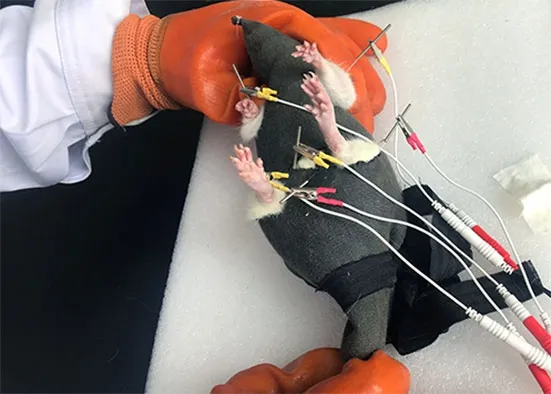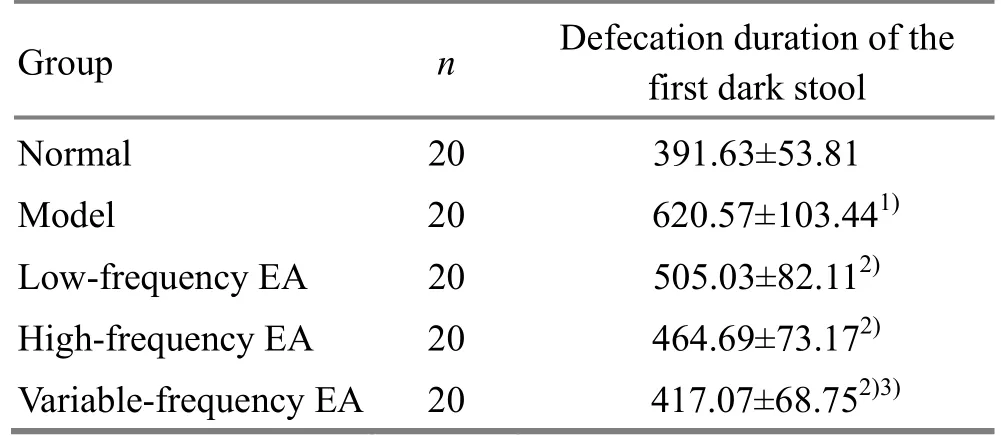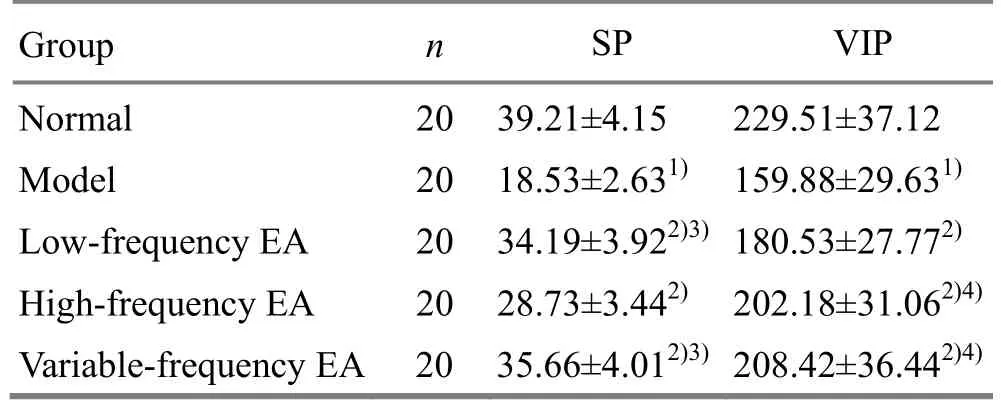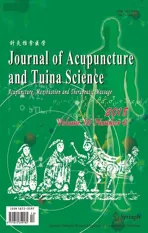Effects of electroacupuncture of different frequencies on SP and VIP expression levels in colon of rats with slow transit constipation
2019-01-14ZhaoBo赵博LiuBoxin刘博鑫LiXiaofeng李晓峰GaoFei高飞ZhangShen张莘ZhangHuizhen张会珍LiangYulei梁玉磊ZhangXuanping张选平SunYanhui孙彦辉JiaChunsheng贾春生
Zhao Bo (赵博), Liu Bo-xin (刘博鑫), Li Xiao-feng (李晓峰), Gao Fei (高飞), Zhang Shen (张莘), Zhang Hui-zhen (张会珍),Liang Yu-lei (梁玉磊), Zhang Xuan-ping (张选平), Sun Yan-hui (孙彦辉), Jia Chun-sheng (贾春生)
Hebei University of Chinese Medicine, Shijiazhuang 050200, China
Abstract Objective: To observe the effects of electroacupuncture (EA) of different frequencies on the expression levels of substance P(SP) and vasoactive intestinal peptide (VIP) in the colon of rats with slow transit constipation (STC).
Keywords: Acupuncture Therapy; Electroacupuncture; Constipation; Substance P; Vasoactive Intestinal Peptide; Colon; Rats
With the aging population and the changes in modern life rhythms and dietary habits, constipation is becoming a common problem. Constipation not only reduces the quality of life in patients, but also brings negative emotions such as anxiety and restlessness[1].Functional constipation (FC) does not have an organic cause, structural abnormalities or metabolic disorders,and excludes irritable bowel syndrome. Main symptoms of FC are difficulty in defecation, hard stools, incomplete sense of evacuation or reduced stools[2]. According to the characteristics of colon dynamics, FC can be divided into slow transit constipation (STC), functional outlet obstruction constipation (FOOC) and combination of STC and FOOC (CSOC). The intestinal contents are retained in the colon, or the colon passing is slow in STC due to the colonic motility transit disorder. Propulsion rate of the colonic contents was slowed due to the reduced colonic motility, resulting in delayed emptying.At the same time, STC may also be accompanied by other gastrointestinal dysfunction caused by abnormal autonomic dysfunction, such as delayed gastric emptying and intestinal dyskinesia[3]. Patients with STC are mainly characterized by decreased defecation frequency, a hard stool mass or no awareness of defecation. Its pathogenesis and etiology are still unclear. A large number of studies in recent years have shown that the pathogenesis of STC is related to the gastrointestinal regulatory peptides, such as colonic substance P (SP) and vasoactive intestinal peptide (VIP).Abnormal changes in the expression levels of these substances can affect intestinal movement, reduce intestinal excitement and colonic motility, leading to the occurrence of STC[4-6].
Chinese medicine therapies, such as acupuncture,warm needling moxibustion, electroacupuncture (EA)and acupoint application, have good curative effects in the treatment of constipation. In recent years, many studies on acupuncture treatment of constipation have emerged[7-9]. In clinical practice, EA treatment of STC has also achieved good results[10-12], but the selected frequencies of EA are different, and there is no common application standard and scientific comparative study.This study aimed to observe the effects of EA of different frequencies on colonic transit function and expression levels of SP and VIP in STC model rats, to select an appropriate frequency in EA treatment of STC,thus to provide scientific bases for the frequency selection in EA treatment of STC.
1 Materials and Methods
1.1 Laboratory animals and grouping
A total of 100 healthy, mature and clean grade male Sprague-Dawley (SD) rats, weighing 200-250 g, were purchased from the Experimental Animal Center of Hebei Medical University [certificate number: SCXK (Ji)2013-1-003]. The rats were housed in separated cages(5 per cage) and kept in the quiet and ventilated environment with daily light for 12 h and free access to food. The room temperature was 16-25 ℃ with relative humidity of 50%-70%. The rats were randomly divided into 5 groups by random number table method,including a normal group, a model group, a lowfrequency EA group, a high-frequency EA group and a variable-frequency EA group, with 20 rats in each group.
1.2 Instruments and reagents
HANS-200 EA instrument (Beijing University of Traditional Chinese Medicine Saile Electronics Co., Ltd.,China); acupuncture needle (Suzhou Medical Products Factory Co., Ltd., China); compound phenethyl piperidine (Changle Pharmaceutical Factory, Xinxiang City, Henan Province, China); radioimmunoassay kit for iodine (125I) SP, radioimmunoassay kit for iodine (125I)VIP (Beijing Huayi Lite Biotechnology Research Institute,China).
1.3 Model preparation
Rats in the normal group were fed with normal diet,which was prepared by the Institute of Zoology, Hebei Medical University. Rats in the other groups were used to prepare the STC model with the modeling method developed by Liu HF, et al[13]: compound phenethidine was added into the rat diet at a dose of 8 mg/(kg·bw)every day for 120 d. After the designated diet, the model rats showed decreased numbers of defecation and fecal pellets, and also dry and hard fecal matter.The defecation duration of the first dark stool was significantly longer than that of the normal group(P<0.05).
1.4 Intervention groups
Rats in the normal group and the model group were only placed on the device for binding without any intervention, once a day, 15 min/time, for continuous 15 d.
Bilateral Tianshu (ST 25), Zhigou (TE 6) and Zusanli(ST 36) in the EA treatment groups were selected according to the principle of acupoint selection in humans and located by referring the Veterinary Acupuncture[14]and Experimental Acupuncture Science[15].

Figure 1. EA points
Tianshu (ST 25) is on the abdomen of the rats and about 5 mm away from the umbilicus.
Zhigou (TE 6) is on the lateral forelimbs and about 4 mm from the wrist joint between the ulna and the radius.
Zusanli (ST 36) is on the posterolateral side of the knee joints, about 5 mm below the capitulum fibulae.
The rats were placed on a self-made mouse binding device when the modeling was completed. After being routinely sterilized, the acupoints were acupunctured with needles (0.35 mm in diameter and 25 mm in length). Tianshu (ST 25) was acupunctured for about 5 mm, and Zhigou (TE 6) and Zusanli (ST 36) were acupunctured about 3 mm. The EA device was connected to the needle after needle insertion. The low-frequency EA group selected a continuous wave of 2 Hz; the high-frequency EA group selected a continuous wave of 100 Hz; the variable-frequency EA group selected a sparse-dense wave of 2 Hz/100 Hz. The current intensity was determined by the slight trembling of the rat limbs without painful screaming.Once a day, 15 min/time, for continuous 15 d.
1.5 Observation items
1.5.1 Intestinal transit function measurement
After the treatment was completed, the rats in each group were fasted for 24 h, and 2 mL of 100 g/L activated carbon suspension was orally administered.The time from the completion of activated carbon administration to the first dark stool defecation was recorded.
1.5.2 SP and VIP expression levels in colon
Rats in each group were sacrificed by bloodletting,and the middle section (about 2 cm) of the colon was quickly removed by opening the belly. About 2 mL of physiological saline was added after the contaminated blood was removed to obtain a homogenate by grinding.The supernatant was isolated by centrifuge at 3 000 r/min and 4 ℃ for 15 min and stored in a refrigerator at -20 ℃. Radioimmunoassay was used to determine the expression level of SP in the colon using the iodine (125I) SP radioimmunoassay kit, and the expression level of VIP in the colon was determined by the iodine (125I) VIP radioimmunoassay kit.
1.6 Statistical methods
All data were statistically analyzed using SPSS version 13.0 software. Measurement data that conformed to the normal distribution were expressed as mean ±standard deviation (±s), and analyzed using one-way analysis of variance. The difference was statistically significant at P<0.05.
2 Results
2.1 Comparison of the first dark stool defecation duration
Compared with the normal group, the first dark stool defecation duration in the model group was significantly prolonged, and the difference between the two groups was statistically significant (P<0.05); compared with the model group, the first dark stool defecation durations of the low-frequency EA group, the high-frequency EA group and the variable-frequency EA group were significantly shortened (P<0.05); among them, the first dark stool defecation duration in the variablefrequency EA group was significantly shorter than that in the 2 Hz EA group. The difference between the two groups was statistically significant (P<0.05). The details were shown in Table 1.Note: Compared with the normal group, 1) P<0.05; compared with the model group, 2) P<0.05; compared with the lowfrequency EA group, 3) P<0.05
Table 1. Comparison of the first dark stool defecation duration of rats in each group (±s, minute)

Table 1. Comparison of the first dark stool defecation duration of rats in each group (±s, minute)
Group n Defecation duration of the first dark stool Normal 20 391.63±53.81 Model 20 620.57±103.441)Low-frequency EA 20 505.03±82.112)High-frequency EA 20 464.69±73.172)Variable-frequency EA 20 417.07±68.752)3)
2.2 Comparison of the SP and VIP expression levels in colon
Compared with the normal group, the SP and VIP expression levels in colon of the model group were significantly decreased, and the differences between the two groups were statistically significant (P<0.01).The SP and VIP expression levels in colon of the lowfrequency EA group, the high-frequency EA group and the variable-frequency EA group were significantly higher than those in the model group (all P<0.05);compared with the high-frequency EA group, the SP expression levels in colon of the low-frequency EA group and the variable-frequency EA group were significantly increased (both P<0.05); compared with the low-frequency EA group, the VIP expression levels in the colon of the high-frequency EA group and the variable-frequency EA group were significantly increased (both P<0.05). The details were shown in Table 2.
Table 2. Comparison of the SP and VIP expression levels in colon of each group (±s, pg/mL)

Table 2. Comparison of the SP and VIP expression levels in colon of each group (±s, pg/mL)
Note: Compared with the normal group, 1) P<0.05; compared with the model group, 2) P<0.05; compared with the high-frequency EA group, 3) P<0.05; compared with the low-frequency EA group, 4) P<0.05
Group n SP VIP Normal 20 39.21±4.15 229.51±37.12 Model 20 18.53±2.631) 159.88±29.631)Low-frequency EA 20 34.19±3.922)3) 180.53±27.772)High-frequency EA 20 28.73±3.442) 202.18±31.062)4)Variable-frequency EA 20 35.66±4.012)3) 208.42±36.442)4)
3 Discussion
Chinese medicine believes that the human body is an organic whole, and the coordination of various organs is the basis of health. The occurrence of constipation is related to dysfunctions of the human body. Zhang JP,et al[16]believe that its etiology is closely related to the liver, lung, spleen and kidney; the liver failing to maintain the normal flow of qi, impairment of purifying and descending function of the lung, dysfunction of the spleen in transportation, and loss of warmth in the kidney would cause weakness in large intestinal transit,thus leading to the occurrence of STC.
STC, also known as colonic weakness, is characterized by decreased colonic motility and slow colonic propagation[17]. STC is more common in the elderly, and its symptoms are similar to the deficient constipation in traditional Chinese medicine. Its pathogenesis is related to the lack of qi-blood and body fluid.
EA therapy refers to the connection of the EA instrument after the needle is inserted into the acupoints. The pulse current of the EA device acts on the needle to vibrate the needle body to strengthen the needle sense, enhance the acupoint stimulation and promote intestinal peristalsis. Tianshu (ST 25) is the Front-Mu point of the large intestine. It is an acupoint where Yangming meridian qi deeply gathers in the intestines and the abdomen; Zusanli (ST 36) is the He-Sea point of the Stomach Meridian and the Lower He-Sea point of the stomach. Acupuncture at Zusanli(ST 36) can smooth the organs and promote qi circulation. Zhigou (TE 6) is the best to regulate the qi movement of three jiao, which can help regulate the intestinal organ, dredge the stagnation and pass stools.A large number of clinical cases show that the above acupoints are the main points for treatment of constipation, especially the STC[18-20].
The pathogenesis of STC remains to be further clarified. Recent studies have shown that the occurrence of STC is associated with abnormalities in certain gastrointestinal regulatory peptides[4]. There are dozens of gastrointestinal regulatory peptides[21],among which, the excitatory neurotransmitters mainly include SP and the inhibitory neurotransmitters mainly include VIP. SP strongly stimulates the smooth muscle to contract, which can promote intestinal movement,reduce intestinal mucosal electrolyte and water transportation. VIP is an inhibitory neurotransmitter that inhibits intestinal movement and regulates intestinal water metabolism to increase intestinal secretion. Therefore, the reduction of both can affect the effective propulsion of the colon, leading to the occurrence of STC[22]. There have occurred many studies on EA for constipation in recent years[5,7,10-12,19,23-27]. The frequencies of EA selected by doctors are different,including 2 Hz, 100 Hz, 2 Hz/15 Hz, 2 Hz/100 Hz, etc.,and each doctor uses a single frequency, lacking a comparison between different frequencies. In this experiment, to compare the effects of different EA frequencies, a representative low-frequency of 2 Hz,high-frequency of 100 Hz and variable-frequency of 2 Hz/100 Hz were selected for comparative study, thus to guide the EA frequency selection for the treatment of STC.
The results of this experiment showed that EA treatment at three different frequencies can effectively improve the intestinal transit function of STC model rats,thus to treat STC. The comparison of intestinal transit function showed that the defecation duration of the first dark stool in the variable-frequency EA group was significantly shorter than that in the low-frequency EA group (P<0.05). The SP and VIP expression levels in colon of each group indicated that the 100 Hz high-frequency and 2 Hz/100 Hz variable-frequency EA stimulation had better effect on improving colonic transit function in STC rats.
There are many factors causing STC. In this experiment, only the intestinal transit time, and SP and VIP expression levels in the colon have been studied.Further research is needed in the future to observe the effects of different EA frequencies on other factors causing STC. This will provide reliable theoretical bases for selecting the most suitable EA frequency in clinical practice.
Conflict of Interest
There was no potential conflict of interest in this article.
Acknowledgments
This work was supported by National Natural Science Foundation of China (国家自然科学基金项目, No.81473773); Project of Hebei Provincial Natural Science Foundation of China (河北省自然科学基金项目, No.H2015423048).
Statement of Human and Animal Rights
The treatment of animals conformed to the ethical criteria in this experiment.
Received: 18 April 2018/Accepted: 9 May 2018
猜你喜欢
杂志排行
Journal of Acupuncture and Tuina Science的其它文章
- Experimental study on the effect of An-pressing and Rou-kneading Huantiao (GB 30) on certain brain nuclei of pleasure circuits in rats with chronic neuralgia
- Fire-needle therapy for deglutition disorders in post-stroke pseudobulbar palsy:a randomized controlled trial
- Memory response to manual acupuncture in chronic insomniacs: evidence from event-related potentials
- Therapeutic effect observation on acupuncture plus umbilicus application with Chinese medicine in treating detrusor underactivity
- Effect of tuina exercise on simple obesity in college students
- Clinical observation on tuina plus foot bath with Chinese medicine for diabetic foot in early stage
